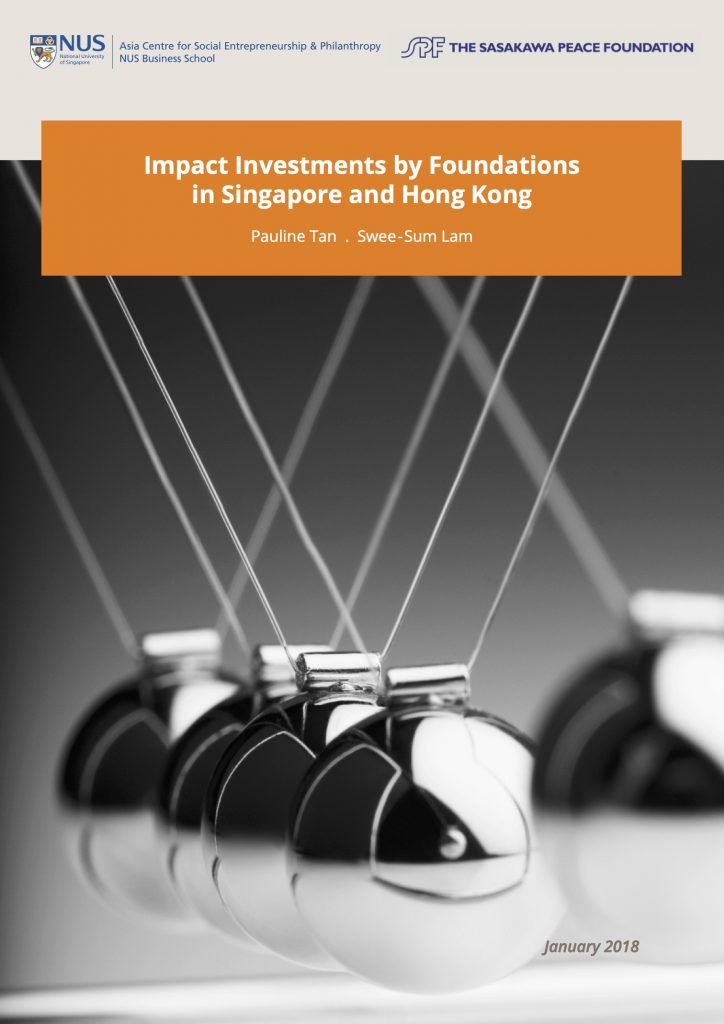January 2018
The study reviews the current state of impact investments in Singapore and Hong Kong, particularly those that have engaged with foundations. It further looks at the trends and challenges of the impact investment sector before presenting a list of recommendations.
Impact investment assets globally represent a mere 0.2 percent of global wealth as reported by the Global Impact Investing Network. By increasing this share to just two percent, the potential of impact investments can reach over US$2 trillion (UNDP, 2016). Impact investments can play a significant role in sustainable development in the Asia Pacific region, potentially providing socio- economic progress for the billions of people living in the region. Foundations in the region can potentially play a significant role given the billions of assets they can deploy.
In Singapore and Hong Kong, the following trends have been observed in the impact investment sector:
- Heightened interest in impact investing with the presence of more impact investment managers and intermediaries. There is also a spike in participation in impact investing events in the region.
- Impact investments are made predominantly by HNWIs and family offices rather than foundations.
- Interest is driven by millennials, personal values and passions.
- Investments made by impact investors in Singapore tend to be regionally focused while those in Hong Kong tend to be locally and Greater China focused.
There are two main problems facing the impact investment sector in Hong Kong and Singapore, namely early stage development of impact investment sector and market dysfunction. Under the first problem, challenges include:
- Limited evidence of success in impact investment in the local context as most documented case studies of successful impact investments tend to originate from the US and Europe where impact investments have taken root for a much longer time. Even then, the case studies are few compared to the evidence of success that exists for traditional investments.
- Lack of local knowledge and network among impact investment managers in Singapore and Hong Kong as many of the scalable social enterprises in Asia are situated in countries such as Indonesia, Vietnam and China.
- Lack of impact investment managers with long enough track records.
- Long commitment period of impact investment means that patient capital instead of traditional capital is needed.
- Limited Information and lack of transparency.
Under market dysfunction, challenges include:
- Inadequate supply and pipeline of investment grade social enterprises as most of the social enterprises in the region are in the seed and early stages which tend to be non-financing-ready. These are less attractive to the funders.
- Mismatch of impact investment instruments.
Foundations in Singapore and Hong Kong, with billions of assets at their disposal, have the potential to facilitate and catalyse the impact investment sector through their activities. Currently they are already experimenting with impact investing through the provision of grants to social enterprises. However interests are coming disproportionally from millennials who may not be the trustees of the foundations and are making impact investments in their personal capacity.
The key challenges for foundations in Singapore and Hong Kong to engage in local impact investments include:
- Relatively small number of foundations with endowments
- Foundations still commit to traditional philanthropy
- Lack of capabilities to engage in impact investing
- Lack of success stories in local context
- Restrained by established operating principles
- Regulatory concern
Recommendations
Based on our initial findings, we recommend the following action plan in Singapore and Hong Kong to catalyse the impact investment sector for take off.
-
a) Foundationscanactasventurephilanthropiststocatalyseecosysteminfillinggapsincapitalspec- trum to providing patient capital for early stage social enterprises
-
b) Provide longer tenor instruments to build more sustainable social enterprises
-
c) Improve the capacity building of social enterprises by providing tailored training instead of generic training
-
d) Develop focused and practical curriculum for impact investors such as deeper country and sector focused content and more practical know-how to provide guidance on transaction execution, mon- itoring and management beyond the basics that current workshops are covering
-
e) Champion collective impact investments or platforms to alleviate the information asymmetry and lack of experience that have been observed in deal sourcing, due diligence and deal execution for impact investments
-
f) Share information and seek partnerships to unlock greater resources to scale up social solutions
-
g) AdvocateandsharingofsuccessfulAsiancasestudiestodriveconfidenceforimpactinvestmentto go mainstream
-
h) Leadership by big players such as government institutions or big foundations to drive dialogue and interest as a way to demonstrate commitment to and leadership in impact investment.
-
-
The complimentary version of the report can be accessed by submitting the form below.
The full list of the 101 foundations – including information such as their latest annual expenditure, grants disbursed, causes supported, website and email address – is available for purchase at $70. To purchase the full version, please click here. For charities, there is a 15% discount. Please email us at connect@soristic.asia for the discount code.

